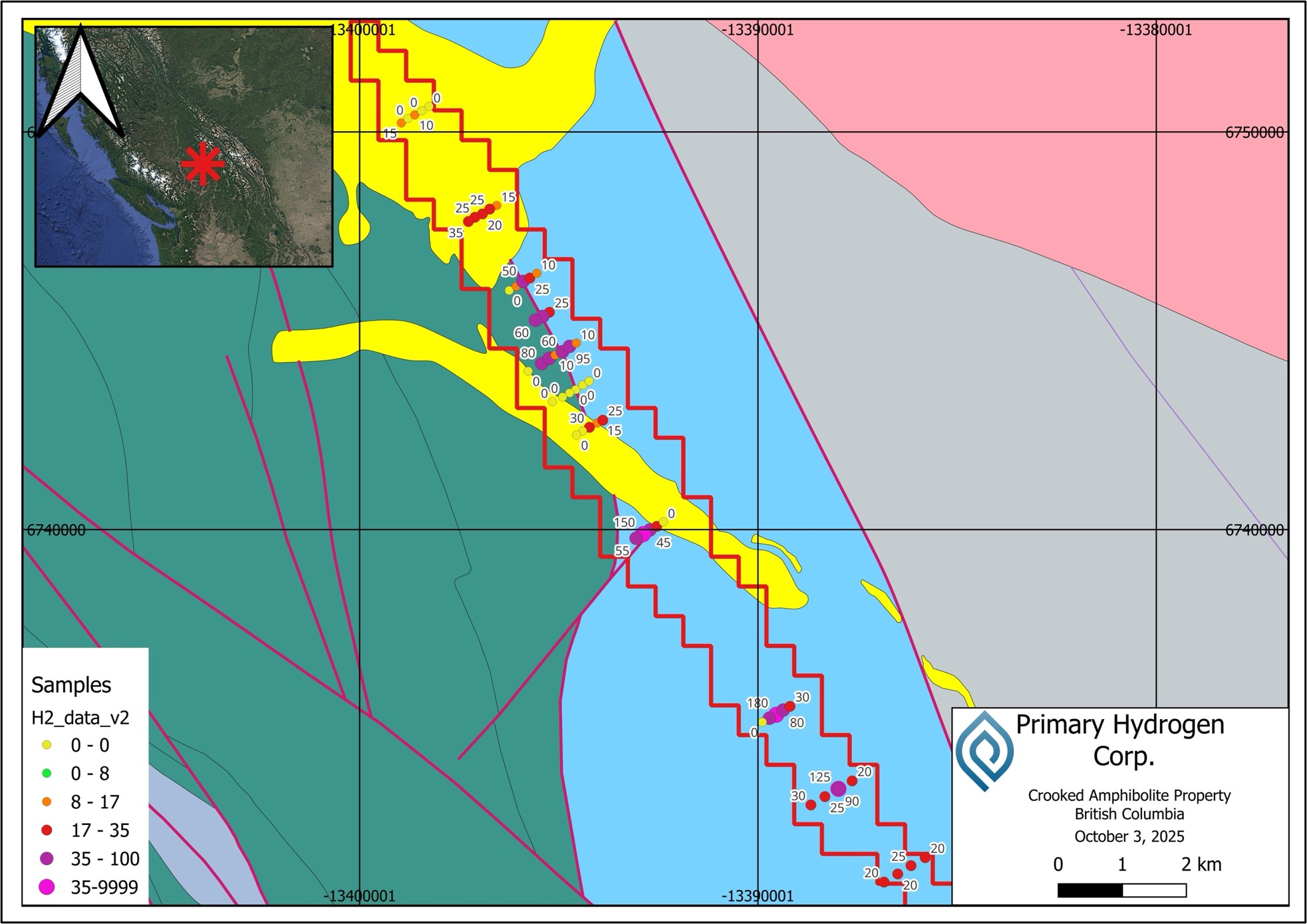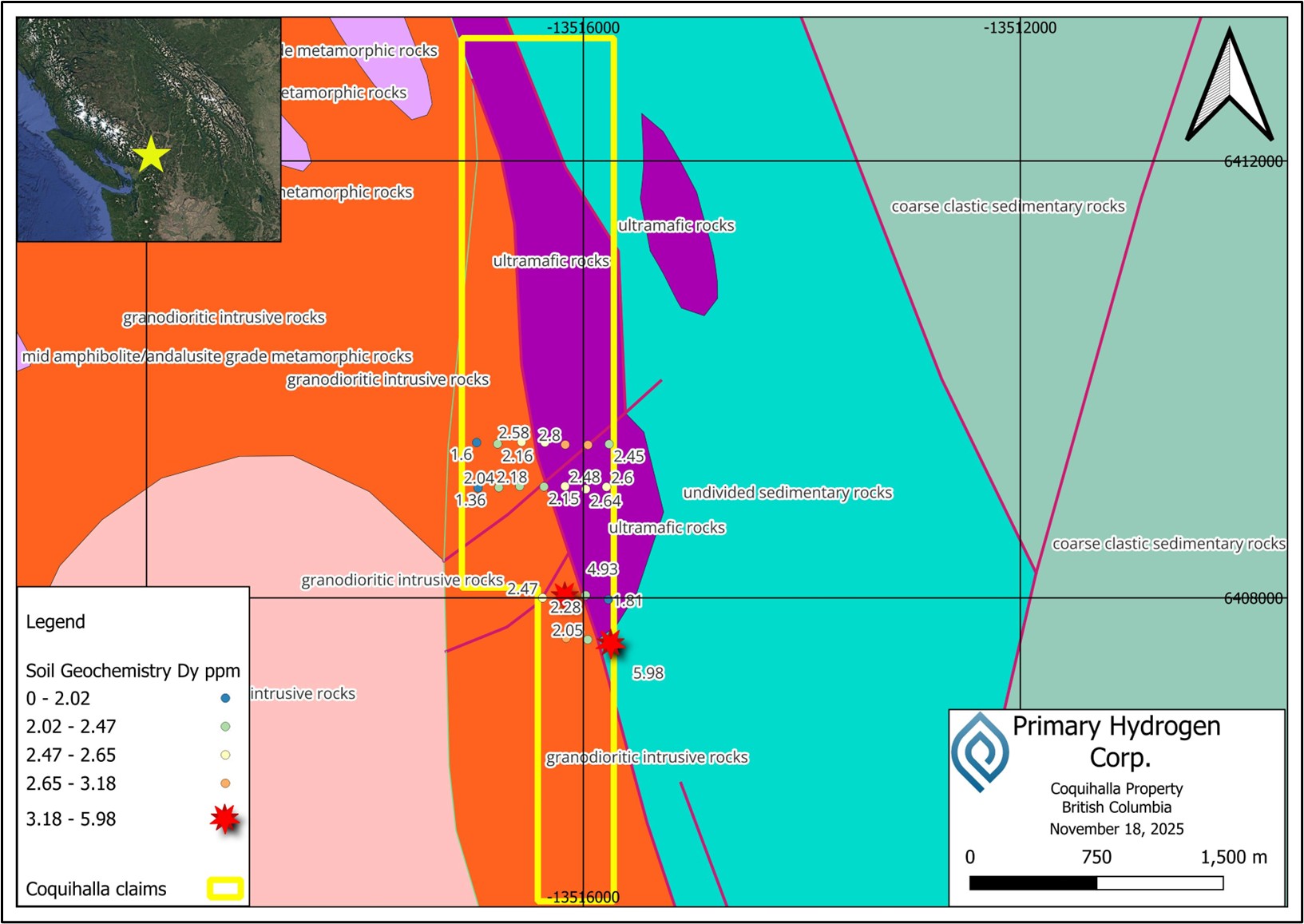
Primary Hydrogen Identifies 8-kilometre Hydrogen Anomaly at Crooked Amphibolite Project in British Columbia
Published by Todd Bush on November 24, 2025
CALGARY, AB / November 24, 2025 / Primary Hydrogen Corp. (TSXV:HDRO)(FRA:83W0)(OTCQB:HNATF) (the "Company" or "Primary Hydrogen") is pleased to announce results from its field sampling program at the Crooked Amphibolite, Coquihalla, and Cogburn projects (collectively the "BC H2 Projects") in British Columbia, Canada. The program identified an approximately 8-kilometre-long trend of elevated hydrogen readings at the Crooked Amphibolite Property, with values up to 180 ppm, as well as an anomalous heavy rare earth element (HREE) zone at the Coquihalla Property with total rare earth oxides (TREO) of 170 ppm.
Program Highlights:
- Crooked Amphibolite Property: Multiple hydrogen readings up to 180 ppm along an ~8-kilometre trend, spatially associated with interpreted fault structures
- Anomalous hydrogen values appear to align with major structural features, suggesting active serpentinization at depth and possible fault-controlled hydrogen migration
- Coquihalla Property: Soil samples revealed HREE anomaly (170 ppm TREO) coincident with a magnetic high, warranting follow-up investigation
- Sampling completed over 3,346 acres across three properties using INRS-validated techniques designed to minimize artificially generated hydrogen
- Results support the geological model for natural hydrogen generation in serpentinized ultramafic terranes
"The Crooked Amphibolite property has delivered encouraging results with hydrogen readings up to 180 ppm distributed along an 8-kilometre trend," stated Peter Lauder, Vice President of Exploration at Primary Hydrogen Corp. "The linear distribution of these anomalies along interpreted fault structures is consistent with our geological model for natural hydrogen generation through serpentinization at depth. This validates our targeting approach and positions Crooked Amphibolite as one of British Columbia's most prospective natural hydrogen exploration targets. The discovery of a HREE soil anomaly at Coquihalla adds further value to our BC portfolio and demonstrates the multi-commodity potential of these ultramafic-hosted terranes."
>> In Other News: XCF Global Welcomes Growing Momentum for Sustainable Aviation Fuel Adoption in the United States
Program Overview
The field sampling program was conducted by Tripoint Geological Services under the supervision of Peter Lauder, P.Geo., VP of Exploration, and was completed in Q3/2025. The program utilized sampling techniques designed and tested by the Institut National de la Recherche Scientifique (INRS) to minimize artificially produced hydrogen. A total of 41 soil samples and numerous soil gas measurements were collected across the three properties, covering an aggregate area of 3,346 acres.
Crooked Amphibolite Property - Soil Gas Results
The Crooked Amphibolite Property geology is dominated by serpentinized mafic and ultramafic rocks, which represent key indicators of naturally occurring hydrogen (NOH) potential. The serpentinization process-whereby ultramafic rocks react with water at elevated temperatures-is well-established as a source of hydrogen. The property is structurally complex, with major thrust faults and strike-slip faults crisscrossing the region. These faults can act as both migration pathways for hydrogen and potential accumulation mechanisms, particularly where they intersect serpentinized ultramafic bodies.

Figure 1: Crooked Amphibolite Property - Soil Gas Hydrogen Results
Multiple sampling stations on the Crooked Amphibolite Property yielded elevated hydrogen readings with values up to 180 ppm, distributed along an approximately 8-kilometre trend (see Figure 1). The trend is interrupted near the center of the property by a gap where saturated ground conditions prevented optimal gas sampling. The highest hydrogen values are typically surrounded by moderate values, suggesting gradual dissipation away from source zones. The linear nature of the anomalous readings suggests that an active fault system may be tapping into zones of active serpentinization at depth and potentially acting as a conduit for hydrogen migration.
The Company believes that additional sampling will be required to further define the extent and intensity of the hydrogen anomaly. Employing sampling techniques pioneered by Primary Hydrogen and INRS, the Company may undertake closer-spaced sampling and utilize alternative probe types to validate and refine the initial observations.
Coquihalla Property - Soil Sampling Results
Soil samples collected from the central portion of the northern claim area on the Coquihalla Property revealed an anomalous concentration of heavy rare earth elements with a TREO value of 170 ppm. This anomaly is spatially correlated with a magnetic high and may be attributed to enrichment associated with adjacent ultramafic units. Alternatively, these soil anomalies could be indicative of an undiscovered rare earth element deposit. Further sampling and analysis will be required to validate this hypothesis and determine the source and significance of the HREE enrichment.

Figure 2: Coquihalla Property - Dysprosium in Soils
Despite the presence of serpentinized ultramafic rocks situated along fault structures, the Coquihalla Property yielded no above-background hydrogen readings in soil gas sampling. Similarly, the Cogburn Property produced only one sample with hydrogen values above background levels (175 ppm). Soil geochemistry results across all properties showed no correlation between hydrogen values and other elements analyzed, which is consistent with hydrogen's high mobility and tendency to rapidly escape to the atmosphere.
Exploration Program Methodology
The exploration program integrated portable gas detectors (Dräger X-am 8000) for immediate in-field measurements with conventional geological exploration techniques, including soil sampling, prospecting, and geological mapping. Soil gas sampling involves the collection and analysis of gases present in soil pores near the surface, helping to detect anomalies potentially indicative of subsurface hydrogen accumulations. This integrated approach is specifically aimed at efficiently identifying the presence of natural hydrogen at surface levels while simultaneously refining the Company's geological understanding of potential hydrogen generation sources, migration pathways, and accumulation zones.
Primary Hydrogen's sampling methodology and procedures have been collaboratively developed with INRS, leveraging laboratory-verified techniques to ensure consistent, reliable results and minimize artificially generated hydrogen. The collected data will inform subsequent exploration phases and increase confidence in the identification and evaluation of prospective natural hydrogen targets.
Qualified Person
The technical information in this news release has been reviewed and approved by Mr. Peter Lauder, P.Geo., V.P. Exploration for Primary Hydrogen Corp. Mr. Lauder is the Qualified Person responsible for the scientific and technical information contained herein under National Instrument 43-101 standards.
About Primary Hydrogen Corp.
Primary Hydrogen is dedicated to the exploration and development of natural hydrogen resources. With over 740 acres in the U.S. and 230 square kilometers across Canada, the Company's portfolio includes the Blakelock, Hopkins, Mary's Harbour, Point Rosie, Crooked Amphibolite, Coquihalla, and Cogburn projects. Primary has an option to acquire a 75% interest in a hydrogen-REE project known as Wicheeda North located in British Columbia.
Subscribe to the newsletter
Daily decarbonization data and news delivered to your inbox
Follow the money flow of climate, technology, and energy investments to uncover new opportunities and jobs.
Latest issues
-
The CO₂ Pipeline Everyone Said Couldn’t Happen
Inside This Issue 🛠️ Tallgrass Found the CO2 Pipeline Formula Others Missed 🚂 HyOrc & Zeltech Advance Practical Locomotive Retrofit Pathway as U.S. Rail Emissions Face Growing Scrutiny 💰 Secre...
-
How 45Q Credits Revived This Troubled $9B Megaproject
Inside This Issue 💰 How 45Q Credits Revived This Troubled $9B Megaproject 🍁 Commencement of First Phase Operations for a Carbon Capture and Storage (CCS) Project in Canada 🤝 Haffner Energy Secures...
-
The Deal Structure Everyone's About to Copy
Inside This Issue 💼 The Deal Structure Everyone's About to Copy 📈 Exxonmobil Raises Its 2030 Plan – Transformation Delivering Higher Earnings, Stronger Cash Flow, and Greater Returns ⚡ Nextera Wor...
Company Announcements
-
C2X to Deliver 3.6 Million Metric Tons of Carbon Removal to Microsoft Over 12 Years
HOUSTON, TEXAS, December 11, 2025: C2X Ltd. has, through its subsidiary Beaver Lake Renewable Energy LLC (Beaver Lake), signed a long-term agreement with Microsoft for the sale and purchase of high...
-
Sandpiper Chemicals Selects Air Water Gas Solutions as ASU Provider for Its Blue Methanol Facility
Sandpiper Chemicals, LLC is pleased to announce that it has selected Air Water Gas Solutions Inc. as its presumptive industrial gases supplier for its Texas City, TX blue methanol facility. Air Wa...
-
SOUTH SAN FRANCISCO, Calif. — (BUSINESS WIRE) — Ebb, a climate and water technology company, has signed a prepurchase agreement with Google to remove 3,500 tons of CO₂ from the atmosphere. The agre...
-
KBR Awarded Green Ammonia Project by IGNIS in Spain
HOUSTON, Dec. 15, 2025 (GLOBE NEWSWIRE) — KBR, Inc. (NYSE: KBR) announced today that it has been awarded a technology and engineering contract by IGNIS for a new green ammonia facility in A Coruña,...